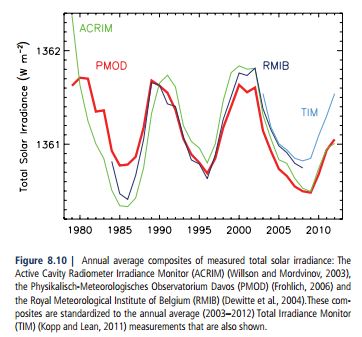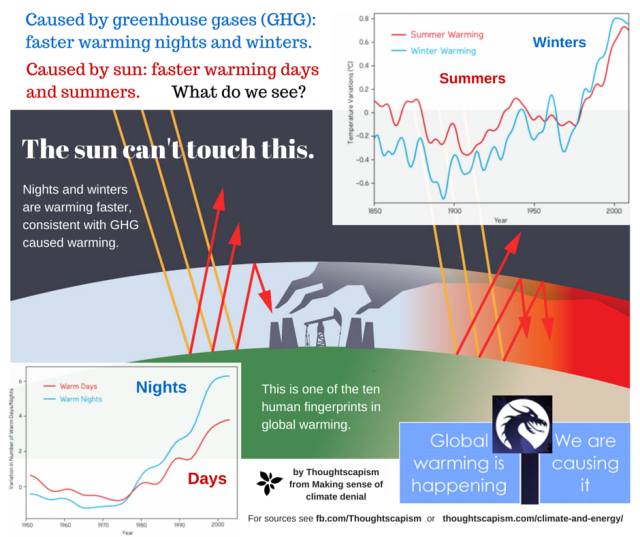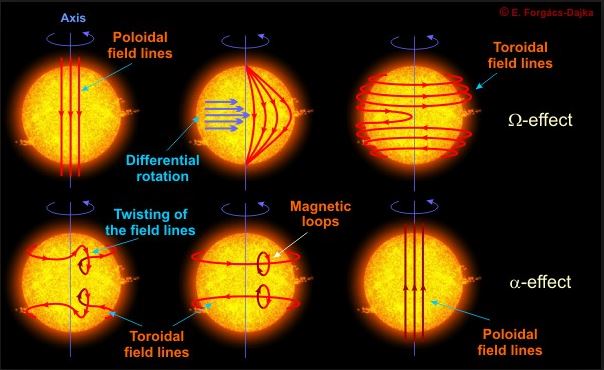In part I of this series on the sun and Earth’s climate, I covered the characteristics of the sun’s 11 and 22 year cycles, the observed laws which describe the behavior of the sunspot cycle, how proxy data is used to reconstruct a record of solar cycles of the past, Grand Solar Maxima and Minima, the relationship between Total Solar Irradiance (TSI) and the sunspot cycle, and the relevance of these factors to earth’s climate system. In part II, I went over the structure of the sun, and some of the characteristics of each layer, which laid the groundwork for part III, in which I explained the solar dynamo: the physical mechanism underlying solar cycles, which I expanded upon in part IV, in which I talked about some common approaches to solar dynamo modeling, including Mean Field Theory. This installment covers how all of that relates to climate change and the current warming trend.
Solar Cycles and Earth’s Climate
The sun is responsible for nearly all of the energy entering our climate system, so it should come as no surprise that variations in Total Solar Irradiance throughout solar cycles do indeed affect Earth’s climate (Eddy 1977, Bond 2001, Solanki 2002, de Jager 2008). Knowing this, it’s natural to wonder whether solar variations are to blame for the current global warming trend. There’s nothing irrational about wondering “hey, you know that gigantic fusion reactor fireball thing in the sky? What if that thing has something to do with global warming and climate change?” I want to emphasize that this is by no means a crazy or unreasonable question to ask. It’s just that with the current warming we’re not just looking at cyclical oscillations or subtle fluctuations; we’re looking at a clear trend (NOAA 2016, Anderson et al 2013, Hansen et al 2010). And changes in solar activity are simply not sufficient to explain that rate and magnitude of the current trend (Frohlich 1998, Meehl et al 2004, Wild 2007, Lean and Rind 2008, Duffy 2009, Gray et al 2010, Kopp 2011).

Image 1 c/o Myhre et al in IPCC Report 2013.

Image 2 c/o Myhre et al IPCC Report 2013.
It has been estimated that climate forcings attributable to solar variability have not contributed more than 30% of the global warming from 1970 – 1999 (Solanki 2003). To add insult to injury, 15 of the 16 hottest years on the instrumental record have occurred since the turn of the millennium, and more recent analyses have found that the solar activity and global temperature trends have been moving in opposite directions in recent cycles (Lockwood and Frohlich 2007 and 2008, Lockwood 2009). Moreover, researchers have found that the warming trend becomes even clearer after correcting for El Niños and volcanic and solar forcings (Foster 2011).
That’s right! Solar activity has actually declined in the last decade, and this last cycle (solar cycle 24) has been well below average amplitude (Jiang 2015, Pesnell 2016). So if changes in solar activity were the principle determinant of the recent changes, we should expect to be experiencing cooling: not warming. So this is also ruled out as a principle cause of late 20th century and early 21st century global warming and resultant climate change. Look at how solar forcings stack up against the observed temperature curve from Meehl et al 2004.

Image 3: c/o Meehl 2004
Firstly, if greenhouse gases are primarily responsible, we should expect to see little change in the amount of solar energy entering the earth’s atmosphere, but a decrease in the amount leaving. Contrastingly, if the sun is primarily responsible, we should expect to see an increase both in the energy entering earth’s atmosphere and the amount leaving. Since the mid-late 1970s, we’ve been able to measure this with satellites.
Lo and behold! It turns out that the rate of energy coming in from the sun has changed very little, while the rate at which energy leaves the earth has decreased significantly (Harries 2001, Griggs and Harries 2007, Philipona 2004, Leroy 2008, Worden 2008, Huang et al 2010). This is the proverbial smoking gun evidence that recent climate change is not due to changes in solar forcing, but rather to the greenhouse effect.
Secondly, if the warming effects were attributable primarily to the sun, then we should be seeing a very different distribution of temperatures than what we are actually observing. Specifically, warming due to solar forcing should be most prominent during the daytime and during the summer months, because these are the times during which the sun is most intensely bombarding the earth.

Image 4 via Thoughtscapism and Making Sense of Climate Science Denial
However, what we observe instead is that night time and winter temperatures are increasing faster than would be the case if the sun was chiefly responsible for the trend (Alexander et al 2006, Caesar et al 2006). This distribution cannot be explained by natural variability, but is consistent with the predictions of the greenhouse effect explanation (Brown 2008). The energy is entering the climate system during the day when the sun is shining, and is getting trapped by greenhouse gases, which slows down the rate at which that energy can escape the earth’s atmosphere. Alexander et al in particular found that over 70% of the land area sampled showed a significant increase in the occurrence of warm nights annual from 1951 – 2003, and a corresponding decrease in the occurrence of cold nights (Alexander et al 2006). So, here we have multiple lines of smoking gun evidence unanimously converging on the conclusion that current climate change cannot be blamed on changes in solar activity.
Could a Grand Minimum Mitigate 21st Century Global Warming?
Okay, so we know that variations in Total Solar Irradiance can’t account for the current warming trend, but what if we just lucked out and entered a new Grand Solar Minimum? How likely is it that it would stop or reverse the trend, and make the last few decades of climate science research and undesirable predictions seem like much ado about nothing? This possibility has been investigated in several papers as well. Although the predictions vary slightly insofar as the precise amounts by which TSI and temperatures would be reduced, they all arrive at reductions in TSI of no greater than a few watts per square meter, a slowing of ascending temperatures by no more than 0.1 – 0.3 °C, and therefore imply that a 21st Century Grand Minimum would (at most) slightly slow global warming down temporarily without actually stopping it (Wigley et al 1990, Feulner and Rahmstorf 2010, Jones et al 2012, Meehl et al 2013, Anet et al 2013, Maycock et al 2015). One might reason that any delay in the warming trend would be better than nothing, because it might buy some time for the innovation and implementation of mitigation and/or coping strategies, and I would not be compelled to argue against that, but the current weight of the evidence suggests that it would be of only marginal help at best.
Conclusion
In summary, solar cycles can affect earth’s weather and climate, both on decadal scales in correspondence with the 11 year sunspot cycle, as well as longer term amplitude changes associated with grand solar maxima and minima.
The prevailing scientific theory for the mechanism underlying these cycles is the solar dynamo, which explains the associated magnetic field oscillations in terms of a branch of physics called magnetohydronamics. It accounts for the observed sunspot butterfly diagrams, Sporer’s Law, Joy’s Law, and Hale’s Polarity Law, and explains the 11 and 22 year cycle periods. Mean Field theory is one of the ways in which stellar astrophysicists simplify solar dynamo model calculations, but it has its limitations.
Multiple lines of evidence suggest the current warming trend on earth is not caused by an increase in solar activity. We know from satellite data that there has been no substantial increase in the amount of solar energy (TSI) entering earth’s climate system, but less of it has been making it back out into space. Moreover, winter and night time warming has increased rapidly, which is consistent with the greenhouse effect explanation, but not with the solar forcing explanation.
Additionally, if a 21st Century Grand Solar Minimum were to occur, it would most-likely have a noticeable but small slowing effect on Global Warming and the resultant Climate Change.
What we humans should do about this is not a strictly scientific question, because it depends not only on model predictions but also on normative issues, personal values, and cost-benefit analyses of different potential solution strategies (both technological and political). However, what we do know with VERY high confidence is that global warming and climate change are happening, and that the sun is not to blame for it.
BOOM!!
Related Articles:
- How Continental Drift affects Climate: Part I – Plate Tectonics, Albedo, and the SnowBall Earth Hypothesis
- How Continental Drift affects Climate: Part II – Possible Snowball Earth Triggering Mechanisms + Regional Effects of Mountain Ranges
- Milankovitch Cycles and Climate: Part I – Axial Tilt and Precession
- Milankovitch Cycles and Climate: Part II – Orbital Eccentricity, Apsidal Precession and Orbital Inclination
- Milankovitch Cycles and Climate: Part III – Putting it All Together
- The Climatological effects of Volcanic Eruptions: The End Permian Extinction, the Toba Super-Volcano, and the Volcanic Explosivity Index
- The Ultimate Environmental Cataclysm: Asteroid and Comet Impacts and their Effects on Climate
- The Sun and Earth’s Climate: The Solar Cycle and the Maunder Minimum
- The Structure and Properties of the Sun
- The Solar Dynamo: The Physical Basis of the Solar Cycle and the Sun’s Magnetic Field
- Mean Field Theory and Solar Dynamo Modeling
References:
Alexander, L. V., Zhang, X., Peterson, T. C., Caesar, J., Gleason, B., Klein Tank, A. M. G., … & Tagipour, A. (2006). Global observed changes in daily climate extremes of temperature and precipitation. Journal of Geophysical Research: Atmospheres, 111(D5).
Anderson, D. M., Mauk, E. M., Wahl, E. R., Morrill, C., Wagner, A. J., Easterling, D., & Rutishauser, T. (2013). Global warming in an independent record of the past 130 years. Geophysical Research Letters, 40(1), 189-193.
Anet, J. G., Rozanov, E. V., Muthers, S., Peter, T., Brönnimann, S., Arfeuille, F., … & Schmutz, W. K. (2013). Impact of a potential 21st century “grand solar minimum” on surface temperatures and stratospheric ozone. Geophysical Research Letters, 40(16), 4420-4425.
Bond, G., Kromer, B., Beer, J., Muscheler, R., Evans, M. N., Showers, W., … & Bonani, G. (2001). Persistent solar influence on North Atlantic climate during the Holocene. Science, 294(5549), 2130-2136.
Brown, S. J., Caesar, J., & Ferro, C. A. (2008). Global changes in extreme daily temperature since 1950. Journal of Geophysical Research: Atmospheres, 113(D5).
Caesar, J., Alexander, L., & Vose, R. (2006). Large‐scale changes in observed daily maximum and minimum temperatures: Creation and analysis of a new gridded data set. Journal of Geophysical Research: Atmospheres, 111(D5).
Cox, P. M., Betts, R. A., Jones, C. D., Spall, S. A., & Totterdell, I. J. (2000). Acceleration of global warming due to carbon-cycle feedbacks in a coupled climate model. Nature, 408(6809), 184-187.
De Jager, C. (2008). Solar activity and its influence on climate. Neth. J. Geosci. Geologie En Mijnbouw, 87, 207-213.
Duffy, P. B., Santer, B. D., & Wigley, T. M. (2009). Solar variability does not explain late-20th-century warming. Physics Today, 62(1), 48.
Eddy, J. A. (1977). Climate and the changing sun. Climatic Change, 1(2), 173-190.
Feulner, G., & Rahmstorf, S. (2010). On the effect of a new grand minimum of solar activity on the future climate on Earth. Geophysical Research Letters, 37(5).
Foster, G., & Rahmstorf, S. (2011). Global temperature evolution 1979 – 2010. Environmental Research Letters, 6(4), 044022.
Frohlich, C., & Lean, J. (1998). The Sun’s total irradiance: Cycles, trends and related climate change uncertainties since 1976. Geophys. Res. Lett, 25(23), 4377-4380.
Gray, L. J., Beer, J., Geller, M., Haigh, J. D., Lockwood, M., Matthes, K., … & Luterbacher, J. (2010). Solar influences on climate. Reviews of Geophysics, 48(4).
Griggs, J. A., & Harries, J. E. (2007). Comparison of spectrally resolved outgoing longwave radiation over the tropical Pacific between 1970 and 2003 using IRIS, IMG, and AIRS. Journal of climate, 20(15), 3982-4001.
Hansen, J., Ruedy, R., Sato, M., & Lo, K. (2010). Global surface temperature change. Reviews of Geophysics, 48(4).
Harries, J. E., Brindley, H. E., Sagoo, P. J., & Bantges, R. J. (2001). Increases in greenhouse forcing inferred from the outgoing longwave radiation spectra of the Earth in 1970 and 1997. Nature, 410(6826), 355-357.
Huang, Y., Leroy, S., Gero, P. J., Dykema, J., & Anderson, J. (2010). Separation of longwave climate feedbacks from spectral observations. Journal of Geophysical Research: Atmospheres, 115(D7).
Jiang, J., Cameron, R. H., & Schuessler, M. (2015). The cause of the weak solar cycle 24. The Astrophysical Journal Letters, 808(1), L28.
Jones, G. S., Lockwood, M., & Stott, P. A. (2012). What influence will future solar activity changes over the 21st century have on projected global near‐surface temperature changes?. Journal of Geophysical Research: Atmospheres, 117(D5).
Karl, T. R., & Trenberth, K. E. (2003). Modern global climate change. science, 302(5651), 1719-1723.
Kopp, G., & Lean, J. L. (2011). A new, lower value of total solar irradiance: Evidence and climate significance. Geophysical Research Letters, 38(1).
Lean, J. L., & Rind, D. H. (2008). How natural and anthropogenic influences alter global and regional surface temperatures: 1889 to 2006. Geophysical Research Letters, 35(18).
Leroy, S., Anderson, J., Dykema, J., & Goody, R. (2008). Testing climate models using thermal infrared spectra. Journal of Climate, 21(9), 1863-1875.
Liverman, D. (2007). From uncertain to unequivocal. Environment: Science and policy for sustainable development, 49(8), 28-32.
Lockwood, M., & Fröhlich, C. (2007, October). Recent oppositely directed trends in solar climate forcings and the global mean surface air temperature. In Proceedings of the Royal Society of London A: Mathematical, Physical and Engineering Sciences (Vol. 463, No. 2086, pp. 2447-2460). The Royal Society.
Lockwood, M., & Fröhlich, C. (2008, June). Recent oppositely directed trends in solar climate forcings and the global mean surface air temperature. II. Different reconstructions of the total solar irradiance variation and dependence on response time scale. In Proceedings of the Royal Society of London A: Mathematical, Physical and Engineering Sciences (Vol. 464, No. 2094, pp. 1367-1385). The Royal Society.
Lockwood, M. (2009, December). Solar change and climate: an update in the light of the current exceptional solar minimum. In Proceedings of the Royal Society of London A: Mathematical, Physical and Engineering Sciences (p. rspa20090519). The Royal Society.
Matthews, H. D., Graham, T. L., Keverian, S., Lamontagne, C., Seto, D., & Smith, T. J. (2014). National contributions to observed global warming. Environmental Research Letters, 9(1), 014010.
Maycock, A. C., Ineson, S., Gray, L. J., Scaife, A. A., Anstey, J. A., Lockwood, M., … & Osprey, S. M. (2015). Possible impacts of a future grand solar minimum on climate: Stratospheric and global circulation changes. Journal of Geophysical Research: Atmospheres, 120(18), 9043-9058.
Meehl, G. A., Washington, W. M., Ammann, C. M., Arblaster, J. M., Wigley, T. M. L., & Tebaldi, C. (2004). Combinations of natural and anthropogenic forcings in twentieth-century climate. Journal of Climate, 17(19), 3721-3727.
Meehl, G. A., Arblaster, J. M., & Marsh, D. R. (2013). Could a future “Grand Solar Minimum” like the Maunder Minimum stop global warming?. Geophysical Research Letters, 40(9), 1789-1793.
Min, S. K., Zhang, X., Zwiers, F. W., & Hegerl, G. C. (2011). Human contribution to more-intense precipitation extremes. Nature, 470(7334), 378-381.
NOAA National Centers for Environmental Information, State of the Climate: Global Analysis for Annual 2015, published online January 2016, retrieved on January 8, 2017 from http://www.ncdc.noaa.gov/sotc/global/201513.
NOAA National Centers for Environmental information, Climate at a Glance: Global Time Series, published December 2016, retrieved on January 8, 2017 from http://www.ncdc.noaa.gov/cag/
Pesnell, W. D. (2016). Predictions of Solar Cycle 24: How are we doing?. Space Weather, 14(1), 10-21.
Philipona, R., Dürr, B., Marty, C., Ohmura, A., & Wild, M. (2004). Radiative forcing‐measured at Earth’s surface‐corroborate the increasing greenhouse effect. Geophysical Research Letters, 31(3).
Solanki, S. K. (2002). Solar variability and climate change: is there a link?. Astronomy & Geophysics, 43(5), 5-9.
Solanki, S. K., & Krivova, N. A. (2003). Can solar variability explain global warming since 1970?. Journal of Geophysical Research: Space Physics, 108(A5).
Wigley, T. M., Kelly, P. M., Eddy, J. A., Berger, A., & Renfrew, A. C. (1990). Holocene Climatic Change, 14C Wiggles and Variations in Solar Irradiance [and Discussion]. Philosophical Transactions of the Royal Society of London A: Mathematical, Physical and Engineering Sciences, 330(1615), 547-560.
Wild, M., Ohmura, A., & Makowski, K. (2007). Impact of global dimming and brightening on global warming. Geophysical Research Letters, 34(4).
Worden, H. M., Bowman, K. W., Worden, J. R., Eldering, A., & Beer, R. (2008). Satellite measurements of the clear-sky greenhouse effect from tropospheric ozone. Nature Geoscience, 1(5), 305-308.
Image Credits:
Image 3:
Meehl, G. A., Washington, W. M., Ammann, C. M., Arblaster, J. M., Wigley, T. M. L., & Tebaldi, C. (2004). Combinations of natural and anthropogenic forcings in twentieth-century climate. Journal of Climate, 17(19), 3721-3727.
Images 1 and 2:
Myhre, G., D. Shindell, F.-M. Bréon, W. Collins, J. Fuglestvedt, J. Huang, D. Koch, J.-F. Lamarque, D. Lee, B. Mendoza, T. Nakajima, A. Robock, G. Stephens, T. Takemura and H. Zhang, 2013: Anthropogenic and Natural Radiative Forcing. In: Climate Change 2013: The Physical Science Basis. Contribution of Working Group I to the Fifth Assessment Report of the Intergovernmental Panel on Climate Change [Stocker, T.F., D. Qin, G.-K. Plattner, M. Tignor, S.K. Allen, J. Boschung, A. Nauels, Y. Xia, V. Bex and P.M. Midgley (eds.)]. Cambridge University Press, Cambridge, United Kingdom and New York, NY, USA, pp. 659–740, doi:10.1017/ CBO9781107415324.018.
Image 4:
Thoughtscapism and Making Sense of Climate Science Denial

coronal mass ejection c/o NASA



3 Comments
Scott Drysdale · April 14, 2017 at 9:36 pm
Epic failure on that hypothesis…..nighttime atmospheric heat retention is due to water molecules in the air from high humidity, cloud cover etc. CO2 does nothing to retain atmospheric heat at night.
Credible Hulk · April 30, 2017 at 2:39 am
This comment is wrong on at least two levels. Firstly, although it’s true that water vapor is a more powerful greenhouse gas, contrarians who use that to downplay the significance of anthropogenic CO2 forcing are neglecting the self-reinforcing feedback loop relationship between water vapor and CO2. When atmospheric concentrations of CO2 go up, it causes average temperatures to increase through the greenhouse effect, which in turn increases water evaporation, thus leading to a further temperature increase through the greenhouse effect, thus increasing evaporation, and so on and so forth.
Climate science contrarians who use this argument are taking that fact out of context to imply that, since increased water vapor is responsible for a large portion of the observed greenhouse effect, human induced CO2 forcing is therefore no big deal, but that is not correct. They are not independent parameters, and representing them as such is extremely disingenuous and/or indicative of a poor understanding of the subject.
Moreover, atmospheric water vapor levels vary constantly via day to day changes in precipitation at any given location, whereas CO2 can remain in the atmosphere for hundreds of years. That means that fossil fuel emissions are driving long term changes in average atmospheric water vapor levels (which had otherwise been relatively stable for a very long time) by increasing average temperatures, and by proxy forcing long term changes in global climate.
Increased CO2 concentrations of anthropogenic origin are AMPLIFYING the greenhouse effects of water vapor. So, the fact that water vapor is a more powerful GHG is ultimately a moot point.
Secondly, the claim that CO2 can’t trap heat at night is completely nonsensical. The heat it traps is not coming directly from the sun, but rather from the infrared heat re-emitted from the ground, which happens both day and night. There is no contingency on daylight hours for CO2 retaining heat, but there IS contingency on daylight hours for radiant heating directly from increased solar irradiation. Plus, we have direct evidence that Total Solar Irradiance has actually decreased: not increased. Therefore your contention is based on faulty assumptions. This is basic physics.
The One True Argument^TM – The Credible Hulk · April 30, 2017 at 2:26 am
[…] the climate with hundreds of citations from credible scientific journals here, here, here, here, here, here, here, here, here, here, here, and […]
Comments are closed.